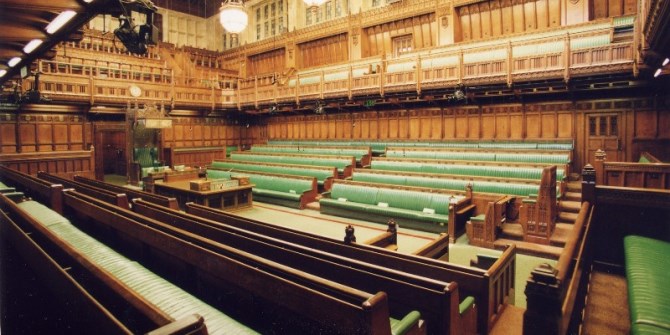 Overall, the manifestos confirm that all parties are unwilling to face up to the political problems they perceive would follow if they advocated solutions that might effectively address the crisis of housing supply. The illness is real but all that is on offer is snake oil; displacement activities treating some symptoms but not the underlying causes and – paradoxically – having the net effect of making the housing crisis worse, writes Paul Cheshire.
Overall, the manifestos confirm that all parties are unwilling to face up to the political problems they perceive would follow if they advocated solutions that might effectively address the crisis of housing supply. The illness is real but all that is on offer is snake oil; displacement activities treating some symptoms but not the underlying causes and – paradoxically – having the net effect of making the housing crisis worse, writes Paul Cheshire.
All the party manifestos are published now. All agree there is a housing crisis. The most recent data for housing starts in England show a fall of 19 per cent in the last quarter of 2014 compared to the post-2008 high or the 2nd quarter of 2014; and completions and planning applications have been flat-lining since 2009. The latest English Housing Survey Headlines showed a continuing rise in age for first time buyers and that the proportion of 25 to 34 year olds who were owner occupiers had fallen from 59 to 36 per cent over 10 years; and for the first time ever, more owner occupiers did not have mortgages than did. In other words all the evidence shows that house building is not significantly rising from what was a 100-year peacetime low in 2010, that the supply and affordability crisis continues – even gets worse – and the redistribution of housing wealth to the elderly continues.
A CentrePiece article last year explained that there had been a shortfall of building during the past 20 years of between 1.6 to 2.3 million and far too many of the houses that had been built were in the wrong places or the wrong type to satisfy demand. But – even worse – that the crisis was self-inflicted by longstanding policies.
Now we have Alice in Wonderland proposals: solutions that require us to believe six impossible things before breakfast and that words mean exactly what the manifestos say – not what they really mean. This will not build houses. Nor will promising to build 200,000 new houses a year (Labour), 230,000 starter homes (Conservative) or – any advance on 200,000? Yes, 300,000 a year (Lib Dem).
Targets and promises do not build houses. The experience of London demonstrates this. Since 2004 housing targets for London have risen from less than 20,000 to 42,000. There was a slight upturn in actual building in the boom conditions of 2004/05 to 24,000. Since then, as targets have risen, so building has fallen. In 2013/14 completions dipped to less than 18,000. To build houses one has to have land to put them on, a realistic diagnosis of the underlying causes and mechanisms for delivering them. Just raising targets or promising more houses simply means a larger shortfall between promise and delivery and an ever increasing unaffordability of housing.
Because the problem is the supply side. Urban containment boundaries were set in 1955 and the area of greenbelt has greatly expanded since then. London’s is now more than 3 times the area of the GLA (and 22 per cent of the GLA is Green Belt); Oxford’s Green Belt is more than 7 times the area of Oxford. Oxford is now the least affordable city for housing in the UK and the city is surrounded by CPRE hotbeds telling them they cannot build here! It is very difficult to build upwards because of planning controls and every proposal to develop becomes an exhausting struggle because each decision is politicised by our mechanism of ‘development control’. Countries which do it more sensibly have plans and what the plan and building regulations permit, can be built.
Of the political manifestos perhaps the Tories’ is the most shameless. Senior Conservatives are not economically illiterate so they really know better. But what they are promising is more demand boosting: not only help to buy but extending the right to buy to houses no government owns; even major property agencies have condemned this proposal. Then the wheeze is to build 200,000 ‘Starter Homes’ to be sold to under-40 first time buyers at a 20 per cent discount (from what?); and a London Land Commission to magically find tracts of Brownfield land that have presumably been hiding behind railway embankments for the past 15 years; and more powers to Local Authorities to resist building on the Green Belt. The Starter Homes, the small print reveals, will be either at the expense of ‘affordable’ housing built as part of planning deals or at the expense of ‘unviable’ commercial development. So not much net new construction there.
One can be entirely confident that the Conservative proposals will do nothing to increase the number of houses built net. This means their proposals will make housing even less affordable because they will subsidise demand but not increase supply. UKIP’s proposals are even less helpful. But then fair enough: one should expect less of UKIP in terms of sensible policies designed to tackle real problems. UKIP want to revise the 2012 National Planning Policy Framework (no evidence this has increased house building but it does offer some slight hope) to make it more difficult to build, increase the extent of Green Belts and extend the right to buy; but to British Nationals only.
Both the Lib Dems and Labour are, amongst other things proposing to build more houses. The trouble is neither really explains how it can be done nor sets out practical mechanisms to do it. So essentially they offer acts of faith. The Lib Dems propose 10 new Garden Cities on a revived Oxford-Cambridge rail link. But apart from some general statements about capturing land value uplift to pay for infrastructure, no mechanism is proposed for getting round the entrenched powers of opposition the current planning system provides anyone who opposes building.
Their other proposals either boost demand without adding to supply (Help to Rent) or have an old fashioned whiff of anti-landlordism and anti-speculator mindsets. They propose giving even more power to local communities to determine development. Without radical complementary changes to taxation, a new system to guarantee new houses come with additional infrastructure and losses are properly compensated this will strengthen the power of NIMBYism even more. A problem of just local decision making is that it empowers those who bear the costs of development (real – noise and dirt during construction, loss of views and more congestion – in the absence of new infrastructure – after the new houses are built) but disenfranchises those who stand to benefit – would-be residents or owners. The Lib Dem proposal to pilot land value taxation is potentially helpful but another proposal – to make planning decisions even more complex by inventing conditions requiring occupation after construction – are not. How on earth could that be imposed? Suppose the market turns down unexpectedly or the developer just gets the local market wrong? It will add yet more risk to the development process so cause otherwise viable projects to slip from viability.
Labour did have the foresight to commission the Lyons Review of Housing but their manifesto conveys the impression they almost wish they had not. They promise to increase house building to 200,000 a year by 2020 but there is no mention of how to increase land supply or funding renewed public sector house building. Instead there is coverage of what seems like an ill-thought out proposal to re-channel finance from Help to Buy ISAs; how to stop ‘land banking’ and ‘speculation’ by introducing ‘use it or lose’ planning permission and double taxation on empty homes. Then there is a proposal to tighten controls on landlords by mandating 3-year tenancies and a national register of private landlords. The most explicit proposal on the supply side is to ‘start to build a new generation of garden cities’. But while Lyons was explicit with details and delivery mechanisms, the manifesto is not. Similarly the Lyons Review had an informed analysis of the underlying problem – our self-imposed shortage of development land; the difficulty of getting across boundary agreements (see the Oxford case) and how over simplistic is the idea of relying on Brownfield land. There is no mention of these serious points in the Labour manifesto.
Overall, the manifestos confirm that all parties are unwilling to face up to the political problems they perceive would follow if they advocated solutions that might effectively address the crisis of housing supply. The illness is real but all that is on offer is snake oil; displacement activities treating some symptoms but not the underlying causes and – paradoxically – having the net effect of making the crisis worse. Perhaps that is just a little harsh on Labour but I did just hear their spokesperson offering the party’s solutions and the whole emphasis was on how the ‘market was not working so the planning system needed to be tougher’. Not so: the problem IS the planning system. It needs root and branch reform but that would take serious political courage.
Fake solutions will not work: in the case of many of those on offer, including discouraging landlords, making an already mind-boggling planning system yet tougher and more complex or boosting demand when the problem is supply, the crisis will get worse. Indeed the housing crisis will get worse anyway without radical reform of the planning system, and local taxes and property taxes; and incentives.
Note: This article gives the views of the author, and not the position of the British Politics and Policy blog, nor of the London School of Economics. Please read our comments policy before posting.
 Paul Cheshire is Emeritus Professor of Economic Geography at the LSE.
Paul Cheshire is Emeritus Professor of Economic Geography at the LSE.








The main source of (slight) hope is that parties prefer to keep the controversial stuff out of their manifestos (any promises of tax rises) and then try to tackle the thorny problems early in their term. So there may be more to come from Labour if they form a government. It almost certainly won’t be enough but it might be more.
Young people can’t afford homes at current prices, so along with building more homes we need a substantial reduction in the price of new homes.
Surely this is the main dilemma.
If prices do come down, I suspect the economic recovery and the building boom will be torpedoed.
If prices do not come down, how are young people going to buy the new homes?
Allow them to borrow more money, bigger mortgages, is the way back to another crash.
One way is to encourage older owners to downsize and recycle their wealth. The conservative policies on inheritance tax seem likely to have the opposite effect.
A Mansion tax could put something of a lid on prices, and even bring prices down in London.